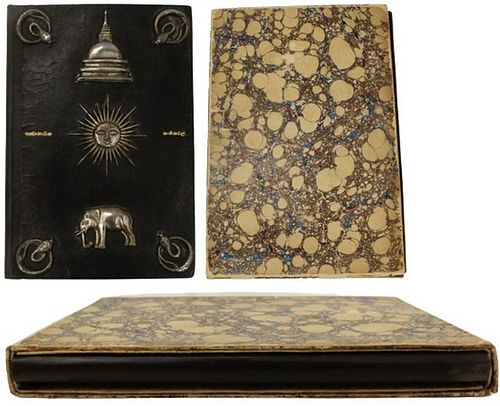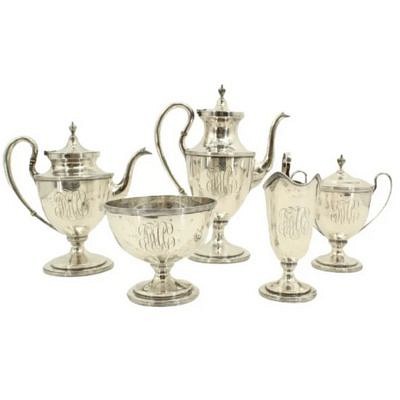Psalmi Penitentiales,William Morris,Kelmscot Press
About Seller
522 South Pineapple Avenue
Sarasota, FL 34236
United States
Sarasota Estate Auction specializes in a wide variety of furniture, antiques, fine art, lighting, sculptures, and collectibles. Andrew Ford, owner and operator of the company, has a passion for finding the best pieces of art and antiques and sharing those finds with the Gulf Coast of Florida.
Two ways to bid:
- Leave a max absentee bid and the platform will bid on your behalf up to your maximum bid during the live auction.
- Bid live during the auction and your bids will be submitted real-time to the auctioneer.
Bid Increments
| Price | Bid Increment |
|---|---|
| $0 | $10 |
| $100 | $25 |
| $250 | $50 |
| $1,000 | $100 |
| $2,500 | $250 |
| $7,500 | $500 |
| $20,000 | $1,000 |
| $50,000 | $2,500 |
| $100,000 | $5,000 |
| $250,000 | $10,000 |
About Auction
Jan 20, 2024
Artists to include: Jorge Blanco, Leonardo Nierman, Picasso, LeRoy Neiman, Darrell Crisp, Francois Krige, Mino Delle Site, Peter Max, Edward Povey, Sky Jones, Robert Rauschenberg, and others. There are also 7 Original Charles Schulz Drawings done by Reuben Timmins, Production Cels, over 200 lots of Important Books and Manuscripts, Sterling Silver, a Jane Kostick Geometric Wooden Sculpture, Modern Design and Furniture, Fantastic Estate Jewelry, and so much more! Sarasota Estate Auction sarasotaestateauction@gmail.com
- Lot Description
Psalmi Penitentiales, William Morris, Kelmscott Press 1894. This book is titled "Psalmi Penitentiales" and was written and bound by William Morris in 1894 at his Kelmscott Press near London and rebound by Don Nicholas Weeraratne in Ceylon in 1896, and it has a beautiful silver overlay and a custom slipcase. The book is in a very rare binding, and it's organized and decorated like a medieval manuscript. The title means "Penitential Psalms", and it is just the kind of work Morris was doing in the 1890's. It's a first edition in red and black ink, in Chaucer type, and one of about 300 unnumbered copies. The front cover has several symbols of Celanese culture - a temple, the sun, snakes, and an elephant - and gilt lettering on either side of the sun. There are blank endpapers and seven more blank endpapers before the title page and text, 60 pages of text and a three-page glossary at the end, and the Kelmscott trademark or colophon just before the glossary reads "Thus ends this rhymed version of the Penitential Psalms found in a manuscript of horae Beatae Mariae Virginis, written at Gloucester about the year 1440, and now transcribed and edited by f. S. Ellis. Printed by William Morris, at the Kelmscott Press, 14, Upper Mall, Hammersmith. finished on the 15th day of November, 1894." The initial letters and borders are printed with flowery decorations. A pencilled note on the last free endpaper says "Bound by Don Nicholas Weeraratne Columbo - Ceylon 1896". We don't know much about Nicholas Weeraratne - it can also be spelled Weerarathne - but Ceylon is now called Sri Lanka. William Morris (1834 - 1896) was a British textile designer, poet, artist, writer, architectural conservationist, printer, and socialist activist associated with the British Arts and Crafts Movement, and a major contributor to the revival of traditional textile arts in Britain. He designed and illuminated books by hand, and was recognized as one of the most significant cultural figures of the Victorian Era, and best known in his lifetime as a poet, but posthumously he became better known for his textile and book designs. He collaborated with Emery Walker to found the Kelmscott Press in 1891, and the press only operated until 1898; it got its name from Kelmscott Manor, Morris's home in Oxfordshire, and the rarity of books published by Morris and the Kelmscott Press cannot be overstated. It only published fifty-three books in sixty-six volumes between 1891 and 1898. Each book was designed and ornamented by Morris and printed by hand in limited editions of around 300, and usually illustrated by Edward Burne-Jones. Kelmscott Press books sought to replicate the style of fifteenth-century printing and were part of the Gothic revival movement. Morris was interested in medieval book design, so Walker enlarged photographs of typefaces for Morris to trace and take inspiration from; Morris then drew his new font design in the enlarged size, and Walker in turn reduced them afterwards to be used in their books. Morris invented three distinctive typefaces - Golden, Troy, and Chaucer - with the text being framed with intricate floral borders similar to those in illuminated medieval manuscripts. Morris loved the aesthetics of fifteenth-century books and modeled his margins and spacing after them; he put smaller spaces between words and lines to create a block of text, and had large outer margins where he put shoulder-notes. With Golden Type, Morris did not make an italic or bold version font and did not include brackets or dashes, and he used paragraph symbols instead of indentations to achieve the look he preferred. You can see that here - there are no indented paragraphs to help a reader find where an idea started and where it ended - Morris just used red ink for titles and to introduce paragraphs - and the outer margins are wider than the margins near the binding. Morris designed different printer's marks for a Kelmscott Press trademark or colophon: a simple text mark in a rectangle used with octavos and small quartos, and a large rectangle with an intricate leafy background, which is the trademark used at the end of the book here. The Press closed shortly after Morris's death, but has exerted a huge influence on book production throughout the world, and even though Morris and the Kelmscott Press were focused on returning to fifteenth-century designs, they still used the modern Victorian technology of photography in its art - a precursor to much of our computer technology today. The book is 8 Vo. and measures 8 1/2 x 5 7/8 in. wide and is clean and tight; the spine was repaired by the Green Dragon Press, based on a note in the front of the book, and this is a first edition of a rare book in a great binding. #1 #1671
- Shipping Info
-
SHIPPING INFORMATION·
Sarasota Estate Auction IS NOT RESPONSIBLE FOR SHIPPING. All shipping will be handled by the winning bidder. Sarasota Estate Auction recommends obtaining shipping quotes before bidding on any items in our auctions. If you are interested in obtaining any information on local shippers, please send us an email and we will kindly send you a list of local shippers. Refunds are not offered under any circumstances base on shipping issues, this is up to the buyer to arrange this beforehand.
Premier Shipping, info@premiershipment.com
BIDDER MUST ARRANGE THEIR OWN SHIPPING. Although SEA will NOT arrange shipping for you, we do recommend our shipper Premier Shipping & Crating at info@premiershipment.com You MUST email them, please do not call. If you'd like to compare shipping quotes or need more options, feel free to contact any local Sarasota shippers. You can email any one of the shippers below as well. Be sure to include the lot(s) you won and address you would like it shipped to. Brennan with The UPS Store #0089 - 941-413-5998 - Store0089@theupsstore.com AK with The UPS Store #2689 - 941-954-4575 - Store2689@theupsstore.com Steve with The UPS Store #4074 - 941-358-7022 - Store4074@theupsstore.com Everett with PakMail - 941-751-2070 - paktara266@gmail.com
-
- Payment & Auction Policies
-
Available payment options
We accept all major credit cards, wire transfers, money orders, checks and PayPal. Please give us a call at (941) 359-8700 or email us at SarasotaEstateAuction@gmail.com to take care of your payments.
-
- Buyer's Premium



 EUR
EUR CAD
CAD AUD
AUD GBP
GBP MXN
MXN HKD
HKD CNY
CNY MYR
MYR SEK
SEK SGD
SGD CHF
CHF THB
THB


























